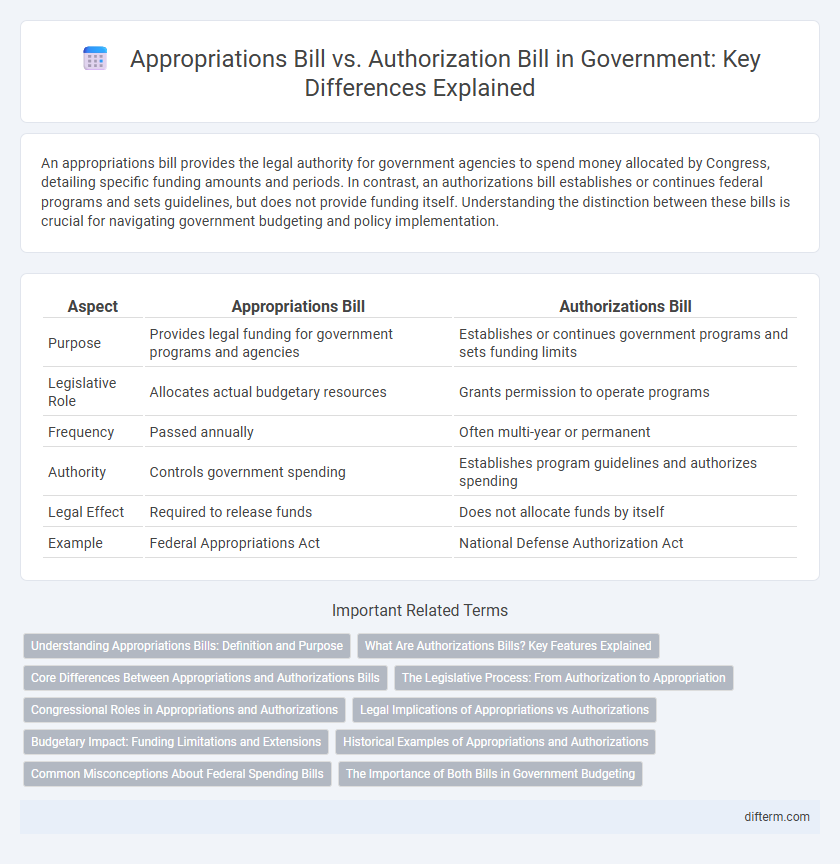An appropriations bill provides the legal authority for government agencies to spend money allocated by Congress, detailing specific funding amounts and periods. In contrast, an authorizations bill establishes or continues federal programs and sets guidelines, but does not provide funding itself. Understanding the distinction between these bills is crucial for navigating government budgeting and policy implementation.
Table of Comparison
| Aspect | Appropriations Bill | Authorizations Bill |
|---|---|---|
| Purpose | Provides legal funding for government programs and agencies | Establishes or continues government programs and sets funding limits |
| Legislative Role | Allocates actual budgetary resources | Grants permission to operate programs |
| Frequency | Passed annually | Often multi-year or permanent |
| Authority | Controls government spending | Establishes program guidelines and authorizes spending |
| Legal Effect | Required to release funds | Does not allocate funds by itself |
| Example | Federal Appropriations Act | National Defense Authorization Act |
Understanding Appropriations Bills: Definition and Purpose
Appropriations bills are legislative acts that allocate specific federal funds to government agencies and programs for a fiscal year, enabling the actual expenditure of government resources. These bills provide the legal authority necessary for federal agencies to incur obligations and make payments from the Treasury. Unlike authorization bills, which establish, continue, or modify programs, appropriations bills control the amount and timing of government spending.
What Are Authorizations Bills? Key Features Explained
Authorization bills establish, modify, or continue federal programs and set policy guidelines while specifying maximum funding levels without providing actual budget allocations. They grant legal authority for government agencies to operate and run programs, often including conditions on how funds should be used. Unlike appropriations bills, authorization bills do not allocate funds but serve as a prerequisite for the later appropriations process and funding distribution.
Core Differences Between Appropriations and Authorizations Bills
Appropriations bills provide the legal authority for federal agencies to incur obligations and make payments from the Treasury, essentially funding government programs for a fiscal year. Authorization bills establish, continue, or modify federal programs and agencies, specifying the terms and conditions under which funds may be spent but do not allocate actual funds. The core difference lies in that authorization bills create or revise programs, while appropriations bills allocate the money necessary to operate those programs.
The Legislative Process: From Authorization to Appropriation
The legislative process begins with an authorizations bill that establishes or continues a federal program and sets its funding limits, providing legal authority for government activities. The appropriations bill follows by allocating the actual funds necessary to execute the program as authorized by Congress, translating policy into budgeted resources. This two-step process ensures that authorized programs receive congressional approval before federal funds are disbursed, maintaining fiscal oversight and accountability.
Congressional Roles in Appropriations and Authorizations
Congressional roles in appropriations and authorizations involve distinct processes where authorizations establish or continue federal programs and set funding limits, while appropriations provide actual funding. Authorization bills, typically passed by standing committees, grant legal authority and program guidelines, whereas appropriations bills, managed primarily by the House and Senate Appropriations Committees, allocate specific dollar amounts to these programs. The separation ensures legislative oversight and control over government spending, with appropriations bills required annually to fund authorized programs.
Legal Implications of Appropriations vs Authorizations
Appropriations bills and authorizations bills serve distinct legal functions in the federal budgeting process, with appropriations providing the legal authority to allocate specific funds for government programs, while authorizations establish or continue federal agencies and programs and recommend funding levels. Legal implications arise from the fact that appropriations bills enforce spending limits mandated by Congress, ensuring compliance with budgetary control and preventing unauthorized expenditures. Failure to pass appropriations results in government shutdowns or delays, whereas authorizations without appropriations lack financial effect, highlighting their complementary roles in legal governance of public funds.
Budgetary Impact: Funding Limitations and Extensions
Appropriations bills allocate specific funding amounts to federal programs and agencies, directly impacting budget execution by setting precise spending limits for the fiscal year. Authorization bills establish or continue programs and recommend funding levels but do not provide actual budget authority, often allowing for multi-year funding structures or extended program operations. The interplay between these bills determines government spending flexibility, with appropriations bills enforcing enforceable budget constraints while authorizations offer policy guidance and potential funding ceilings.
Historical Examples of Appropriations and Authorizations
The 2018 National Defense Authorization Act (NDAA) exemplifies an authorizations bill, establishing policies and setting funding limits for the Department of Defense, while the subsequent 2018 appropriations bill provided the actual budgetary allocations. Historically, the 1970s saw disputes between Congress and the Nixon administration over appropriations that led to the establishment of stronger congressional control over federal spending. Another notable example is the 2013 budget impasse where failure to pass appropriations bills resulted in a government shutdown, highlighting the critical role of timely appropriations in government operations.
Common Misconceptions About Federal Spending Bills
Appropriations bills provide the legal authority to spend federal funds allocated in the budget, while authorizations bills establish or continue government programs and set funding limits without actual funding. A common misconception is that authorization bills directly allocate money, but only appropriations bills permit actual expenditure of funds. Understanding the distinct roles of these bills is crucial for accurate analysis of federal spending processes.
The Importance of Both Bills in Government Budgeting
Appropriations bills allocate specific funding for government programs and agencies based on previously authorized activities, providing legal authority to spend public funds. Authorizations bills establish, modify, or continue federal programs, setting program objectives and guidelines without direct funding. Both bills are essential for effective government budgeting, ensuring that programs are properly reviewed, authorized, and financially supported in a legally accountable process.
appropriations bill vs authorizations bill Infographic

 difterm.com
difterm.com